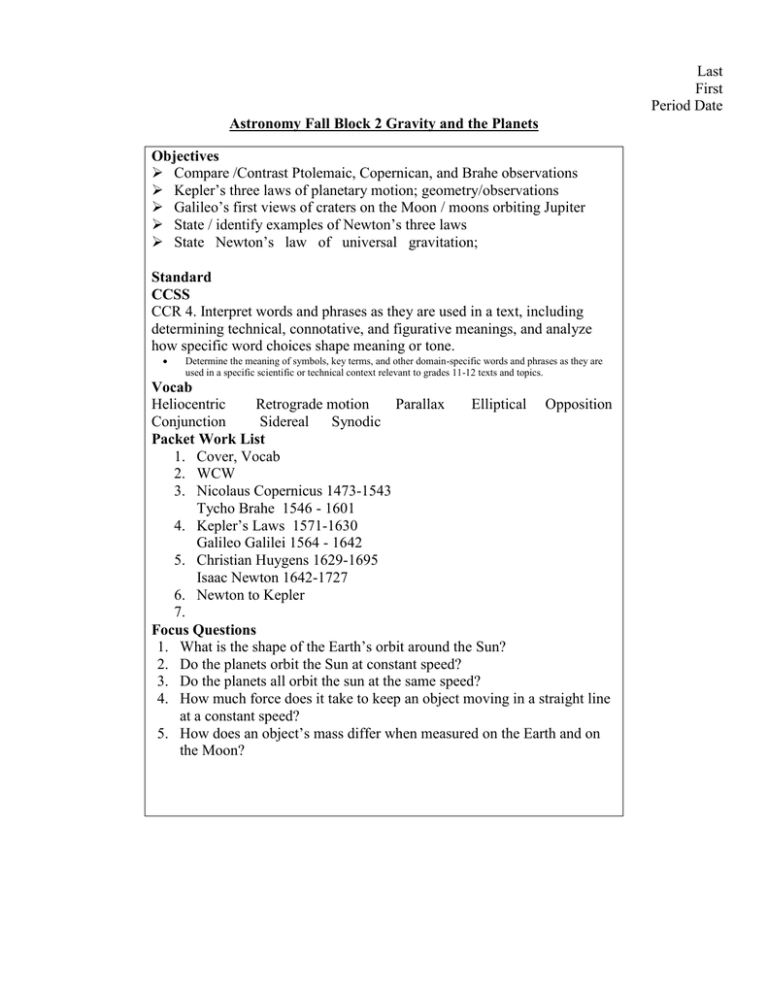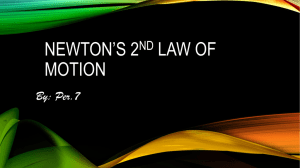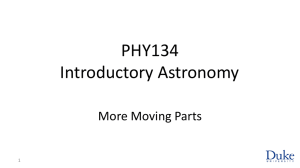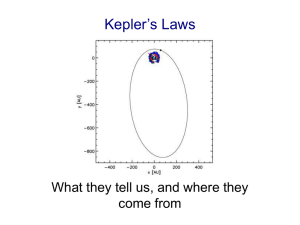of 2. The new acceleration will be ______ m/s2.
advertisement

Last First Period Date Astronomy Fall Block 2 Gravity and the Planets Objectives Compare /Contrast Ptolemaic, Copernican, and Brahe observations Kepler’s three laws of planetary motion; geometry/observations Galileo’s first views of craters on the Moon / moons orbiting Jupiter State / identify examples of Newton’s three laws State Newton’s law of universal gravitation; Standard CCSS CCR 4. Interpret words and phrases as they are used in a text, including determining technical, connotative, and figurative meanings, and analyze how specific word choices shape meaning or tone. Determine the meaning of symbols, key terms, and other domain-specific words and phrases as they are used in a specific scientific or technical context relevant to grades 11-12 texts and topics. Vocab Heliocentric Retrograde motion Parallax Elliptical Opposition Conjunction Sidereal Synodic Packet Work List 1. Cover, Vocab 2. WCW 3. Nicolaus Copernicus 1473-1543 Tycho Brahe 1546 - 1601 4. Kepler’s Laws 1571-1630 Galileo Galilei 1564 - 1642 5. Christian Huygens 1629-1695 Isaac Newton 1642-1727 6. Newton to Kepler 7. Focus Questions 1. What is the shape of the Earth’s orbit around the Sun? 2. Do the planets orbit the Sun at constant speed? 3. Do the planets all orbit the sun at the same speed? 4. How much force does it take to keep an object moving in a straight line at a constant speed? 5. How does an object’s mass differ when measured on the Earth and on the Moon? WCW Block 2 Gravity and the Planets 8/28 thu Warm-up How is the Waltz, the dance, related to the motion of the planets orbiting the Sun? Critical thinking How is an epicycle different from rotation on the axis? Wrap-up The major difference between Geocentric and Heliocentric models of our Solar system is… 9/3 even wed Warm-up How did Copernicus model differ from the Ptolemaic model? Critical thinking What did Kepler change in the Copernican model that allowed it to gain acceptance? Wrap-up Describe the three laws of Newton. 9/5 even fri Warm-up Critical Thinking Wrap-up # 3 Notes Nicholas Copernicus Polish astronomer 1473-1543 Before Ptolemaic model of the solar system which placed Earth at the center of the universe introduced the heliocentric model, centered around the sun all the planets, including Earth, moved in orbits around the sun, and showed how this new system could accurately calculate the positions of the planets Retrograde motion- apparent backward motion of a planet caused by its being lapped by another planet, or vice-versa Mercury and Venus Vs Mars Fewer epicycles than Ptolemaic, observations of a supernova (literally: nova= Danish astronomer 1546-1601 "new star") in 1572 (we now For over twenty years, accurate observations of the know that a supernova is an night sky (over 1000objects) especially mars which exploding star, not a new plays a key role in Kepler’s laws, all without the aid of star). 18 months a telescope, (not invented) observations of a comet in records were used by Johan Kepler to describe the 1577 orbits of planets around the sun and disprove the come tis farther from us then Ptolemaic theory, Mathematically the moon, Aristotle, who had held that comets were atmospheric Tycho Brahe Galileo Galilei Italian astronomer / physicist 1564-1642 Galileo was the first person to use a telescope to look at the heavens. He discovered sunspots, and craters and peaks in the moon. Jupiter had moons also, and other objects seemed to be orbiting the Sun. Johan Kepler German astronomer 1571-1630 He introduced three important laws of planetary motion and helped the Copernican model of the solar system gain general acceptance. Kepler inherited Tycho Brahe's observational data on Mars following Brahe's death and showed, mathematically, that Mars followed an elliptical orbit. This new revelation contradicted the age old belief that heavenly bodies all moved in perfect circles. also cast horoscopes and wrote science fiction novels. Christian Huygens Dutch physicist and astronomer 1629-1695 He found new methods for grinding and polishing lenses, making telescopes more powerful. Using a telescope he had made, Huygens first identified Saturn's rings and one of Saturn's moons. Huygens also invented the pendulum clock, increasing the accuracy of timekeeping, and proposed the wave theory Isaac Newton English scientist and mathematician 1642-1727 Newton’s idea that gravity, the force which keeps us bound to the Earth, also controls the motion of planets and stars. Newton's contributions to science include the universal law of gravitation, the development of a whole new field in mathematics called calculus, and his famous three laws of motion. Opposition-Earth has a shorter orbital period than Mars, we pass in between Mars and the Sun on a fairly regular basis (approx. every 780 days, or 2 years and 50 days). When we do so, we see Mars in the opposite direction from the Sun, at opposition Outer planets Inner planets Sidereal period-1 complete orbit around the sun Synodic period- planet moving from a chosen position and back Tycho Brahe disn’ ancient ideas November 1572, for 18 months light from an exploding star (supernova) was seen Parallax- is an apparent displacement (difference in the position) of an object viewed along two different lines of sight, and is measured by the angle or semi-angle of inclination between those two lines (fyi-angle is displacement also) Kepler’s laws-orbital shapes, changing speeds, planetary years 1st law elliptical orbit Orbital eccentricity- e- (0 circular, 1 near line) Perihelion-closest to sun Aphelion-farthest from sun 2nd law a line joining a planet and the sun sweeps out equal areas in equal time 3rd law- orbital period squared = semi major axis cubed http://qhstearth.blogspot.com/2009/10/homework-geocentric-vs-heliocentric.html http://www.youtube.com/watch?v=QR2vxfwiHAU khan academy Notes Galileo’s heliocentric Early 1600’s proves kepler and Copernicus – telescope invention Two lenses can bring objects closer 30X magnification used to view sky Phases of venus, moon’s craters, saturns rings, satellites orbiting Jupiter, all bodies fall at the same speed in a vacuum Newton 1600’s mid Motion of objects, kepler’s data of planetary motion, Laws http://www.phys.ufl.edu/demo/1_Mechanics/ 1st law Objects remain at constant acceleration unless acted upon by an outside force 2nd law Objects experience a force equivalent to mass times acceleration 3rd law Objects that apply a force experience a force applied on them equal in magnitude and opposite in direction Newton’s gravity vs. Kepler’s laws "inverse square law" "universal" force of gravitation F F = G mM/r2 M mass of Earth, R radius m mass of object F = m GM/R2 = m g g = GM / R2 G universal gravitation Earth, sphere of radius 1 RE = 6,317,000 m If a satellite is in a stable circular orbit and its velocity is V, then F mg = F = mV2/RE Dividing both sides by m shows that the mass of the satellite does not matter, V2/RE = g Frontiers unknown Galileo Galilei Astronomer, Physicist 1564 - 1642 1. What prompted Galileo's thinking about pendulums? __________________________ ___________________________________________________________________________ ___________________________________________________________________________ 2. What is Galileo's Theory of Falling Objects and how did he test it? ___________________________________________________________________________ ___________________________________________________________________________ ___________________________________________________________________________ 3. What is the Ptolemaic Theory? ______________________________________________ ___________________________________________________________________________ 4. What is the Copernican Theory? _____________________________________________ ___________________________________________________________________________ 5. How did Aristotle and Galileo differ in their view of the universe? ___________________________________________________________________________ ___________________________________________________________________________ 6. Define "heliocentrism". ____________________________________________________ ___________________________________________________________________________ 7. What is "heresy" and why was Galileo condemned for it? ___________________________________________________________________________ ___________________________________________________________________________ Newton's Laws: Inertia and Mass 1. Inertia is 2. The amount of inertia possessed by an object is dependent solely upon its __________. 3. Two bricks are resting on edge of the lab table. Shirley She-short stands on her toes and spots the two bricks. She acquires an intense desire to know which of the two bricks are most massive. Since Shirley is vertically challenged, she is unable to reach high enough and lift the bricks; she can however reach high enough to give the bricks a push. Discuss how the process of pushing the bricks will allow Shirley to determine which of the two bricks is most massive. What differences will Shirley observe and how can this observation lead to the necessary conclusion? 4. Would Shirley She-short be able to conduct this same study if she was on a spaceship in a location in space far from the influence of significant gravitational forces? _______ Explain your answer. 5. If a moose were chasing you through the woods, its enormous mass would be very threatening. But if you zigzagged, then its great mass would be to your advantage. Explain why. 6. Inertia can best be described as _____. a. the force that keeps moving objects moving and stationary objects at rest. b. the willingness of an object to eventually lose its motion c. the force that causes all objects to stop d. the tendency of any object to resist change and keep doing whatever it's doing 7. Mass and velocity values for a variety of objects are listed below. Rank the objects from smallest to greatest inertia. _______ < _______ < _______ < _______ Newton's Second Law of Motion 1. The acceleration of an object is __________ related to the net force exerted upon it and____________ related to the mass of the object. In equation form: a = Fnet / m. a. directly, inversely b. inversely, directly c. directly, directly d. inversely, inversely 2. Use Newton's second law to predict the effect of an alteration in mass or net force upon the acceleration of an object. a. An object is accelerating at a rate of 8 m/s2 when it suddenly has the net force exerted upon increased by a factor of 2. The new acceleration will be _________ m/s2. b. An object is accelerating at a rate of 8 m/s2 when it suddenly has the net force exerted upon increased by a factor of 4. The new acceleration will be _________ m/s2. c. An object is accelerating at a rate of 8 m/s2 when it suddenly has the net force exerted upon decreased by a factor of 2. The new acceleration will be _________ m/s 2. d. An object is accelerating at a rate of 8 m/s2 when it suddenly has its mass increased by a factor of 2. The new acceleration will be _________ m/s2. e. An object is accelerating at a rate of 8 m/s2 when it suddenly has its mass decreased by a factor of 4. The new acceleration will be _________ m/s2. f. An object is accelerating at a rate of 8 m/s2 when it suddenly has the net force exerted upon increased by a factor of 2 and its mass decreased by a factor of 4. The new acceleration will be ________ m/s2. g. An object is accelerating at a rate of 8 m/s2 when it suddenly has the net force exerted upon increased by a factor of 4 and its mass increased by a factor of 2. The new acceleration will be________ m/s2. h. An object is accelerating at a rate of 8 m/s2 when it suddenly has the net force exerted upon increased by a factor of 3 and its mass decreased by a factor of 4. The new acceleration will be _________ m/s2. 3. These force diagrams depict the magnitudes and directions of the forces acting upon four objects. In each case, the down force is the force of gravity. Rank these objects in order of their acceleration, from largest to smallest: _______ > _______ > _______ > _______ Object A B C D 50N 50N 50N 50N 20N 50N 50N 10N 40N 15N 30N 50N 50N 50N 50N Newton's Third Law A force is a push or pull resulting from an interaction between two objects.Whenever there is a force, there are two objects involved - with both objects pushing (or pulling) on each other in opposite directions. While the direction of the pushes (or pulls) are opposite, the strength or magnitudes are equal. This is sometimes stated as Newton's Third Law of motion: for every action, there is an equal and opposite reaction. A force is a push or a pull and it always results from an interaction between two objects. These forces always come in pairs. 1. For each stated action force, identify the reaction force. Bat hits ball Man pushes car Helmet hits bug 2. Identify by words the action-reaction force pairs in each of the following diagrams. 3. TRUE or FALSE: As you sit in your seat in the physics classroom, the Earth pulls down upon your body with a gravitational force; the reaction force is the chair pushing upwards on your body with an equal magnitude. If False, correct the answer. 4. Shirley Bored sits in her seat in the English classroom. The Earth pulls down on Shirley's body with a gravitational force of 600 N. Describe the reaction force of the force of gravity acting upon Shirley. 5. Use Newton's third law (law of action-reaction) and Newton's second law (law of acceleration: a = Fnet/m) to complete the following statements by filling in the blanks. a. A bullet is loaded in a rifle and the trigger is pulled. The force experienced by the bullet is ____________ (less than, equal to, greater than) the force experienced by the rifle. The resulting acceleration of the bullet is ____________ (less than, equal to, greater than) the resulting acceleration of the rifle. b. A bug crashes into a high speed bus. The force experienced by the bug is ____________ (less than, equal to, greater than) the force experienced by the bus. The resulting acceleration of the bug is ____________ (less than, equal to, greater than) the resulting acceleration of the bus. c. A massive linebacker collides with a smaller halfback at midfield. The force experienced by the linebacker is ____________ (less than, equal to, greater than) the force experienced by the halfback. The resulting acceleration of the linebacker is ____________ (less than, equal to, greater than) the resulting acceleration of the halfback. d. The 10-ball collides with the 14-ball on the billiards table (assume equal mass balls). The force experienced by the 10-ball is ____________ (less than, equal to, greater than) the force experienced by the 14-ball. The resulting acceleration of the 10-ball is ____________ (less than, equal to, greater than) the resulting acceleration of the 14-ball. UNIVERSAL GRAVITY AND KEPLER'S LAWS WORKSHEET G = 6.67259 x 10-11 (N•m2)/kg2 Earth Sun Mass................................................ 5.98 X 1024 kg Mass.................. 1.99 X 1030 kg Radius..............................................6.38 X 106 m Radius................6.96 X 108 m Mean distance from the Sun..........1.50 X 1011 m Moon Mass................................................ 7.35 X 1022 kg Radius..............................................1.74 X 106 m Mean distance from the Earth........ 3.85 X 108 m 1 What is the force of attraction between a 60.0 kg student in the senior parking lot and the school? The distance between the two is 100.000 m and the mass of the school 65,000,000 kg. 2 You’re on a date with “the significant other.” You are getting close. Your center of masses are 0.50 meters apart. If you have a mass’s of 50.00 kg and 70.00 kg then what is the actual scientific force of attraction between the two of you? 3 Two asteroids, (m1 = 1.00 X 1012 kg and m2 = 5 X 1012 kg), are floating in space. The force of attraction between them is 10.000 N. How far apart are their centers of mass? 4 In a car race, the force of attraction between the 1st and 2nd place cars is 3.0349 X 10 -7N. If the 1st place car has a mass of 700 kg and the 2nd place car has a mass of 650 kg, then what is the distance between the two cars? 5 While on the surface of the the Earth a student has a weight of 450 N. If she is moved twice as far from the center of the Earth, then how does hew new weight compare to her old? 6 How many Earth Radii distances could fit between the center of the Earth and the Center of the moon when it is in orbit around the Earth? If the same 50 kg student in problem #5 is moved out from the surface of the Earth to this distance away from the center of the Earth, then how does her new weight compare to her old? 7 An alien space craft is out in space leaving an unknown planet. It detects the pull of gravity due to this unknown planet to be 100 N. Later the alien rechecks the pull on their space craft and detects it to be 33 N. By what factor has their distance changed as they left the unknown planet? 8 The space shuttle travels at 17,000 mph, 7,589.288 m/s while in orbit. How far away from the SURFACE OF THE EARTH is the shuttle? 9 How fast is the moon traveling as it orbits the Earth? 10A geosynchronous orbit is one where a satellite orbits the Earth with the SAME period of motion as the Earth on it own axis. How far from the center of the Earth is the Satellites orbit? 11 Using Kepler’s 3rd Law of Planetary motion, determine the distance between the center of the Earth and the center of the Moon. 12 Using Kepler’s 3rd Law of Planetary motion, determine the distance between the center of the Earth and the center of the Sun. UNIVERSAL GRAVITY AND KEPLER'S LAWS WORKSHEET 13A planet is in orbit as shown below. Where are the two possible locations for a Sun? 14 The moon Io revolves around Jupiter in 0.0048 sidereal years. Io has an mean orbital radius of 0.0028 Au’s. If the Jupiter moon has a period of rotation of 0.0097 sidereal years, then how far away is Europa from the center of Jupiter? 15 The planet Mercury takes 0.24 sidereal years to go around the sun. What is the distance from the center of Mercury to the center of the sun? 16 The moon takes 27.32 days to revolve around the Earth once. The moon is 25,201 mi from the center of the Earth. The International Space Station orbits in the same orbit as the space shuttle. The International Space Station makes an orbit around the Earth in 90 minutes, then how high up is the International Space Station from the center of the Earth and the surface of the Earth? (The diameter of the Earth is 3950 miles.) Why is this answer different from question #8? 17 The Planet Jupiter’s mean orbital radius is 5.2025 Au’s. What is the period of Jupiter in sidereal years? 18 The planet Pluto is 39.5 Au’s from the Sun. How long does is take to go around the Sun once? 19 Their is belt of asteroids between Mars and Jupiter. This belt circles the “inside” of our solar system and is called the Asteroid belt. This belt has a mean radius from the Sun of 2.6 Au’s. how long does it take for 1 asteroid to in the belt to travel around the Sun once? ORBITAL VELOCITY 20 A satellite is placed in an orbit 16,090,000 meters above the Earth’s Surface. How fast is the satellite traveling to remain in orbit? 21 A space ship is to orbit a planet wtih a mass of 8 X 10 20 kg. How far, from the plant’s center, must the ship travel if it is to travel with a velocity 10,000 m/s? 22 A space craft is to orbit an asteroid of mass 5.00 X 1015 kg at a distance of 55,555 m from the asteroid’s center. What is the space craft’s period of motion and orbital velocity? 23 The Hubble Telescope orbits the Earth 596,000 m ABOVE THE SURFACE of the earth. What is the Telescope’s Period and tangential velocity? UNIVERSAL GRAVITY AND KEPLER'S LAWS WORKSHEET Answers 1. 2.6023 X 10-5N 7. 9 times farther away 15. 5.76 X 1010m 2. 9.3416 X 10-7 N 8. 54,7771.53 m (340 mi) 16. 437.65 miles 3. 5,774,945.887 m 9. 1018.05 m/s 17. 11.87 Au’s 4. 10.0 m 10. 42255942.3 m 18. 248 sidereal years 5. 1/4 the weight, therefore 112.5 N 11., 12., 13., 19. 4.192 sidereal years 6. 60; New =(1/602)OLD 14. 0.00447 Au’s 20. 4979.89 m/s 21 5, 338,072 m 22 2.451 m/s; 142,440 s 23 7563 m/s; 5795.511 s UNIVERSAL GRAVITY AND KEPLER'S LAWS WORKSHEET






